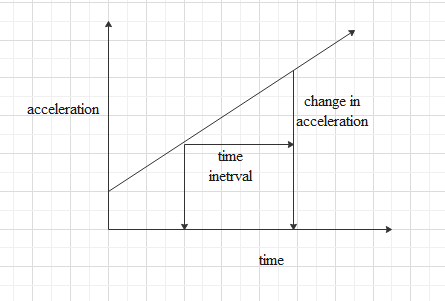
The area under the acceleration-time graph gives:
A.) Distance travelled
B.) Change in direction
C.) Force acting
D.) Change in velocity
Answer
514.5k+ views
Hint: Try to understand the concept of graphs between two physical quantities. Draw an acceleration-time graph. Try to find the area of the graph with the help of physical notations. Then we can find our answer.
Complete step by step answer:
An acceleration-time graph is represented as the acceleration on the y-axis or the vertical axis and time in the x-axis or the horizontal axis. The value of the graph at a particular time will give us the acceleration of the object at that point of time.
Slope of an acceleration-time graph is known as a jerk. It gives us the rate of change of acceleration.

We can find the area under the acceleration-time graph for a certain time interval.
Area under the graph can be defined as,
Where,
Now we can find acceleration as,
So, by multiplying both sides of equation by
So, the area under the acceleration-time graph can be given as,
Which is the rate of change of velocity.
So, the area under any acceleration time graph at a certain time interval will give us the rate of change of velocity.
The correct option is (a).
Note: For a constant acceleration we will get a linear graph parallel to the time axis. If we have a uniformly increasing acceleration, we will get a straight line with a slope. For non-uniform acceleration we won’t get a straight-line graph.
Complete step by step answer:
An acceleration-time graph is represented as the acceleration on the y-axis or the vertical axis and time in the x-axis or the horizontal axis. The value of the graph at a particular time will give us the acceleration of the object at that point of time.
Slope of an acceleration-time graph is known as a jerk. It gives us the rate of change of acceleration.

We can find the area under the acceleration-time graph for a certain time interval.
Area under the graph can be defined as,
Where,
Now we can find acceleration as,
So, by multiplying both sides of equation by
So, the area under the acceleration-time graph can be given as,
Which is the rate of change of velocity.
So, the area under any acceleration time graph at a certain time interval will give us the rate of change of velocity.
The correct option is (a).
Note: For a constant acceleration we will get a linear graph parallel to the time axis. If we have a uniformly increasing acceleration, we will get a straight line with a slope. For non-uniform acceleration we won’t get a straight-line graph.
Latest Vedantu courses for you
Grade 11 Science PCM | CBSE | SCHOOL | English
CBSE (2025-26)
School Full course for CBSE students
₹41,848 per year
Recently Updated Pages
Master Class 11 Economics: Engaging Questions & Answers for Success

Master Class 11 Business Studies: Engaging Questions & Answers for Success

Master Class 11 Accountancy: Engaging Questions & Answers for Success

Master Class 11 English: Engaging Questions & Answers for Success

Master Class 11 Computer Science: Engaging Questions & Answers for Success

Master Class 11 Maths: Engaging Questions & Answers for Success

Trending doubts
State and prove Bernoullis theorem class 11 physics CBSE

1 Quintal is equal to a 110 kg b 10 kg c 100kg d 1000 class 11 physics CBSE

How much is 23 kg in pounds class 11 chemistry CBSE

Find the missing frequency in the following distribution class 11 maths CBSE

Difference between physical and chemical change class 11 chemistry CBSE

Number of oneone functions from A to B where nA 4 and class 11 maths CBSE




